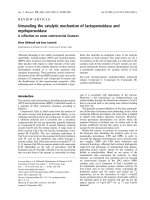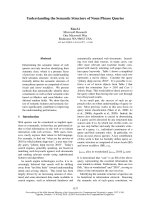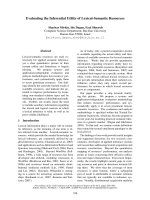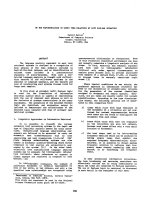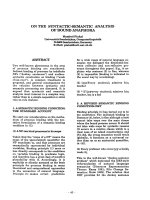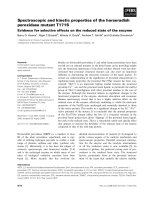Báo cáo khoa học: "ON THE SUCCINCTNESS PROPERTIES OF UNORDERED CONTEXT-FREE GRAMMARS" ppt
Bạn đang xem bản rút gọn của tài liệu. Xem và tải ngay bản đầy đủ của tài liệu tại đây (403.97 KB, 5 trang )
ON THE SUCCINCTNESS PROPERTIES
OF UNORDERED CONTEXT-FREE GRAMMARS
M. Drew Moshier and William C. Rounds
Electrical Engineering and Computer Science Department
University of Michigan
Ann Arbor, Michigan 48109
1 Abstract
We prove in this paper that unordered, or ID/LP
grammars, are e.xponentially more succinct than context-
free grammars, by exhibiting a sequence (L,~) of finite
languages such that the size of any CFG for L,~ must
grow exponentially in n, but which can be described by
polynomial-size ID/LP grammars. The results have im-
plications for the description of free word order languages.
2 Introduction
Context free grammars in immediate dominance and
linear precedence format were used in GPSG [3] as a skele-
ton for metarule generation and feature checking. It is in-
tuitively obvious that grammars in this form can describe
languages which are closed under the operation of taking
arbitrary permutations of strings in the language. (Such
languages will be called symmetric.) Ordinary context-
free grammars, on the other hand, "seem to require that
all permutations of right-hand sides of productions be ex-
plicitly listed, in order to describe certain symmetric lan-
guages. For an explicit example, consider the n-letter al-
phabet E,~ = {al a,~}. Let P,~ be the set of all strings
which are permutations of exactly these letters. It seems
obvious that no context-free grammar could generate this
language without explicitly listing it. Now try to prove
that this is the case. This is in essence what we do in this
paper. We also hope to get the audience for the paper
interested in why the proof works!
To give some idea of the difficulty of our problem, we
begin by recounting Barton's results [1] in this confer-
ence in 1985. (There is a general discussion in [2].) He
showed that the universal recognition problem (URP) for
ID/LP grammars is NP-complete. 1 This means that if
P :~ NP, then no polynomial algorithm can solve this
problem. The difficulty of the problem seems to arise
from the fact that the translation from an ID/LP gram-
mar to a weakly equivalent CFG blows up exponentially.
It is easy to show, assuming P ~ NP, that any reason-
able transformation from ID/LP grammars to equivalent
CFGs cannot be done in polynomial time; Rounds has
done this as a remark in [8]. In this paper, we remove
the hypothesis P ~: NP. That is, we can show that no
algorithm whatever can effect the translation polynomi-
The universal recognition problem is to tell for an ID/LP gram-
mar G and a string
w, whether or not w E
L(G).
ally in all cases. (Unfortunately, this does not solve the
P - NP
question!)
Barton's reduction took a known NP-complete prob-
lem, the vertex-cover problem, and reduced it to the URP
for ID/LP. The reduction makes crucial use of grammars
whose production size can be arbitrarily large. Define the
fan-out of a grammar to be the largest total number of
symbol occurrences on the right hand side of any produc-
tion. For a CFG, this would be the maximum length of
any RHS; for an ID/LP grammar, we would count sym-
bols and their multiplicities. Barton's reduction does the
following. For each instance of the vertex cover problem,
of size n, he constructs a string w and an ID/LP grammar
of fanout proportional to n such that the instance has a
vertex cover if and only if the string is generated by the
grammar. He also notes that if all ID/LP grammars have
fanout bounded by a fixed constant, then the URP can
be solved in polynomial time.
This brings us to the statement of our results. Let Pn
be the language described above. Clearly this language
can be generated by the ID/LP grammar
S al, ,an
whose size in bits is O(n log n).
Theorem 1 There is a constant c > I such that any
contezt-free gr.mmar Gn generating Pn must have size
~(cn). 2 Moreover, every [D/LP grammar'generating pn,
whose fanout is bounded by a fized constant, must likewise
have ezponential size.
The theorem does not actually depend on having a
vocabulary which grows with n. It is possible to code
everything homomorphically into a two-letter alphabet.
However, we think that the result shows that ordinary
CFGs, and bounded-fanout ID/LP grammars, are inade-
quate for giving succinct descriptions of languages whose
vocabulary is open, and whose word order can be very
free. Thus, we prefer the statement of the result as it is.
We start the paper with the technical results, in Sec-
tion 3, and continue with a discussion of the implications
for linguistics in Section 4. The final section contains
a proof of the Interchange Lemma of Ogden, Ross, and
Winklmann [7], which is the main tool used for our re-
suits. This proof is included, not because it is new, but
because we want to show a beautiful example of the use of
2This notation meam.s that for inKnitely ram W n, the size of Gn
must be bigger than
c n.
112
combinatorial principles in formal linguistics, and because
we think the proof may be generalized to other classes of
grammars.
3 Technical Results
As we have said, our basic tool is the Interchange
Lemma, which was first used to show that the "embedded
reduplication" language { wzzy I w, z, and y E {a, b, c}" }
is not context-free. It was also used in Kac, Manaster-
Ramer, and Rounds [6] to show that English is not CF,
and by Rounds, Manaster-Ramer, and Friedman to show
that reduplication even over length n strings requires
context-free grammar size exponential in n. The cur-
rent application uses the last-mentioned technique, but
the argument is more complicated.
We will discuss the Interchange Lemma informally,
then state it formally. We will then show how to apply it
in our case.
The IL relies on the following basic observation. Sup-
pose we have a context-free language, and two strings in
that language, each of which has a substring which is the
yield of a subtree labeled by the same nonterminal sym-
bol at the respective roots of the subtrees. Then these
substrings can be interchanged, and the resulting strings
will still be in the language. This is what distinguishes
the IL from the Pumping Lemma, which finds repeated
nonterminals in the derivation tree of just one string.
The next observation about the IL is that it attempts
to find these interchangeable strings among the length n
strings of the given language. Moreover, we want to find
a whole set of such strings, such that in the set, the inter-
changed substrings all have the same length, and all start
at the same position in the host string. The lemma lets
us select a number m less than n, and tells us that the
length k of the interchangeable substrings is between role
and m, where r is the fanout of the grammar. Finally, the
lemma gives us an estimate of the size of the interchange-
able subset. We may choose an arbitrary subset Q(n) of
L(n), where L(n) is the set of length n strings in the lan-
guage L. If we also choose an integer m < n, then the
IL tells us that there is an interchangeable set A C_ Q(n)
such that IAI _>
IQ(n)I/(INI" n=),
where the vertical bars
denote cardinality, and N is the set of nonterminals of
the given grammar. (The interchanged strings do not
stay in Q(n), but they do stay in L(n). ) Notice that
if Q(n) is exponential in size, then A will be also. Thus,
if a language has exponentially many strings of length
n then it will have an interchangeable subset of roughly
the same exponential size, provided the set of nontermi-
nals of the grammar is small. Our proof turns this idea
around. We show that any CF description of the permu-
tation language L(n) must have an exponentially large
set of nonterminals, because an interchangeable subset of
this language cannot be of the same exponential order as
n!, which is the size of L(n).
Now we can give a more formal statement of the
lem/'fla.
Definition. Suppose that A is a subset {zl -p}
of L(n). A has the k-interchangeability property iff there
are substrings Zh , z v of zl, , z v respectively, such
that each z, has length k, each z~ occurs in the same
relative position in each zi, and such that if z~ = wiziy(
and z i = wjziV j for any i and j, then wi~jVl is an element
of L(n).
Interchange Lemma. Let G be a CFG or ID/LP
grammar with fanout r, and with nonterminal alphabet
N. Let m and n be any positive natural numbers with
r < m_< n. Let L(n) be the set of length nstringsin
L(G), and Q(n) be a subset of L(n). Then we can find
a k-interchangeable subset A of Q(n), such that m/r <_
k _< m, and such that
Ial >_ IQ(n)ll (INI" n2).
Now we can prove our main theorem. First we show
that no CFG of fanout 2 can generate L(n) without an
exponential number of nonterminals. The theorem for
any CFG then follows, because any CFG can be trans-
formed, into a CFG with fanout 2 by a process essentially
like that of transforming into Chornsky normal form, but
without having to eliminate e-productions or unit produc-
tions. This process at most cubes the grammar size, and
the result follows because the cube root of an exponen-
tial is still an exponential. The proof for bounded-fanout
ID/LP is a direct adaptation of the proof for fanout 2,
which we now give.
Let Pn be the permutation language above, and let
G be a fanout 2 grammar for this language. Apply the
Interchange Lemma to G, choosing
Q(n)
= P~, r = 2,
and m = n/2.
(n will be chosen as a multiple of 4.)
Observe that IQ(n)l = IL(n)[ = n!. From the IL, we get a
k-interchangeable subset A of L(n), such that n/4 < k <
n/2, and such that
n!
IAI _> INI" n'-"
Next we use the fact that A is k-interchangeable to get an
upper bound on its cardinality. Let wtztyt and w~.=~.y~.
be members of A, and let E(z) be the set of alphabet
characters appearing in z. We claim that E(zl) = ~(z~_).
For if, say =t has a character not occurring in z~., then
the interchanged string wtz2yl will have two occurrences
of that character, and thus not be in L(n), as required by
the IL. Without loss of generality, ,.V.(z) = {al ak}.
The number of strings in A is thus less than or equal to
the number of ways of selecting the z string - that is, k!,
times the number of ways of choosing the characters in
the rest of the string - that is, (n - k)!. In other words,
IAI < k! (n
- k)!.
Putting the two inequalities together and solving for IN[,
113
we get
INI > k! (n - k)! " n "W = n -~" "
From Pascal's triangle in high school mathematics, (i) in-
creases with k until k -
n/2.
Thus since
n/4 < k < n/2,
we have (i) > (n~4), which by using Stirling's approxi-
mation
m! " , mm e-m~/27rm
to estimate the various factorials, grows exponentially
with n. Therefore, so does IN[, and our theorem is
proved.
To obtain the result for a two-letter alphabet, con-
sider the homomorphism sending the letter aj into 0 j 1.
Let
Ii'n
be the image of Pn under this mapping. Then,
because the mapping is one-to-one, P. is the inverse ho-
momorphic image of
Kn.
If for every c > 1 there is a
sequence of CFGs Gn generating
K,
such that the size of
G,~ is
not
ft(c"), then the same is true for the language
Pn, contradicting Theorem I. The reason is that the size
of a grammar for the inverse homomorphic image of a
language need only be polynomiaUy bigger than the size
of a grammar for the language itself. The proof of this
claim rests on inspection of one of the standard proofs,
say Hopcroft and Ullman [5]. The result is proved us-
ing pushdown automata, but all conversions from pdas
to grammars require only polynomial increase in size.
Our final technical result concerns an n-symbol ana-
logue of the so-called MIX language, which has been con-
jectured by Marsh not to be an indexed language (see
[4] for discussion.) We define the language M, to be the
set of all strings over En which have identical numbers
of occurrences of each character al in En. Observe that
/I,I,~ is infinite for each n. However, there is a sequence of
finite sublanguages of the various Mn, such that this se-
quence requires exponentially increasing context-free de-
scriptions. ~Ve have the following theorem.
Theorem 2
Consider the set Mn(n=) of all length n 2
strings of Mn. Then there is a constant c > 1 such that
any context.free grammar Gn generating Mn(n 2) must
have sue
f~(cn).
Proof.
This proof is really just a generalization of the
proof of Theorem 1. It uses, however, the Q subsets in a
way that the proof of Theorem 1 does not.
First, we drop the n subscript in
Mn(n2).
Observe
next that in every string in
M(n2),
each character in En
occurs exactly n times. Let
O(n 2)
= {u '~ :
lul - n}
be
the subset of M(n 2) where, as indicated, each string is
composed of n identical substrings concatenated in or-
der. Then each u substring must be a permutation of
E,, i.e., a member of P,. Let
Gn
be a fanout 2 gram-
mar generating
M(n2).
As in the proof of Theorem I,
apply the Interchange Lemma to G,~, choosing ~(n 2) as
above, r - 2, and m n/2. Observe that we still have
IQ(n2)l - n!. From the IL, we get a k-interchangeable
subset A of
Q(n2),
such that
n/4 < k < n/2,
and such
that
n!
IAI _> I/Vl.
n4
Once again we use the fact that A is k-interchangeable
to get an upper bound on its cardinaiity. Let wlztyl
and
w2z2y2
be members of .4, and let E(z) be the
set
of alphabet characters appearing in z. We claim once
again that E(zt) - Z(z2). To see this, notice that the
z portions of the strings in A can overlap at most one of
the boundaries between the successive u strings, because
]u] n and
[z[ <_ n/2.
If it does not overlap a bound-
ary, then the reasoning is as before. If it does overlap a
boundary, then we claim that the characters in z occur-
ring to the right of the boundary must all be different
from the characters in z to the left. This is because of
the "wraparound phenomenon": the u strings are iden-
tical, so the z characters to the right of the boundary
are the same characters which occur to the right of the
previous
u-boundary. Since each u is a permutation of
En, the claim holds. The same reasoning now applies to
show that r-(zt) - E(z2). For if, say, zt has a charac-
ter not occurring in z2, then one of the u-portions of the
interchanged string
wxz2yx
will have two occurrences of
that character, and thus not be in M(n~), as required by
the IL. Without loss of generality, E(z) - {at a~}.
The number of strings in A is less than or equal to the
number of ways of selecting one of the u strings. Consider
the u string to the left of the boundary which z overlaps.
Because of wraparound, this u string is still determined
by selecting k positions in the z, and then choosing the
characters in the remaining n - k positions. Thus we still
have
IAI < k! (n - k)!
and we
finish
the proof as above.
4 Discussion
What do Theorems I and 2 literally mean as far as
linguistic descriptions are concerned? First, we notice
that the permutation language P,~ really has s counting
property: there is exactly one occurrence of each sym-
bol in any string. The same is true if we consider, for
fixed m, the strings of length mn in Mn, as n varies.
Here there must be exactly m occurrences of each symbol
in En, in every string. It seems unreasonable to require
this counting property as a property of the sublanguage
generated by any construction of ordinary language. For
example, a list of modifiers, say adjectives, could allow
arbitrary repetitions of any of its basic elements, and not
insist that there be at most one occurrence of each modi-
fier. So these examples do not have any direct, naturally
occurring, linguistic analogues. It is only if we wish to
describe permutation-like behavior where the number of
occurrences of each symbol is hounded, but with an un-
114
bounded number of symbols, that we encounter difficul-
ties.
The same observation, however, applies to Barton's
NP-cornpleteness result. Exactly the same counting prop-
erty is required to make the universal recognition problem
intractable. If we do not insist on an n-character alpha-
bet, of course, then the universal recognition problem is
only polynomial for ID/LP grammars; and correspond-
ingly, there is a polynomial-size weakly equivalent CFG
for each ID/LP grammar. But even with a growing al-
phabet, it is still possible that direct ID/LP recognition
is polynomial on the average. One way to check this pos-
sibility empirically would be to examine long utterances
(sentences) in actual fragments of free word-order lan-
guages, to see whether words are repeated a large num-
ber of times in those utterances. If there is a bound, and
if all permutations are equally likely, then the above re-
sults may have some relevance. It is definitely the case
that speculations about the difficulty of processing these
languages should be informed by more actual data. How-
ever, it is equally true that the conclusions of a theoretical
investigation can suggest what data to collect.
5 Proof of the IL
Here we repeat the proof of the IL due to Ogden et al.
It is an excellent example of the combinatory fact known
as the Pigeonhole Principle. As we said, we want to en-
courage
more cooperation between theoretical computer
science and linguistics, and part of the way to do this is to
give a full account of the techniques used in both areas.
First we restate the lemma.
Interchange Lemma. Let G be a CFG or ID/LP
grammar with fanout r, and with nonterminal alphabet
N. Let m and n be any positive natural numbers with
r < m <_ n. Let L(n)
be the set of length n strings in
L(G),
and Q(n) be a subset of
L(n).
Then we can find
a k-interchangeable subset .4 of ~(n), such that
m/r <
k _< m, and such that
IAI >_ IQCn)I/(I.'Vl • rib.
Proof.
The proof breaks into two distinct parts: one
involving the Pigeonhole Principle, and another involving
an argument about paths in derivation trees with fanout
r. The two parts are related by the following definition.
Fix n, r, and m as in the statement of the IL. A
tuple (j, k, B), where j and k are integers between i and
n, and where B E N, is said to describe a string z of
length n, if (i) there is a (full) derivation tree for z in
G, having a subtree whose root is labeled with B, and
the subtree exactly covers that portion of z beginning at
position j, and having length k; and (ii) k satisfies the
inequality stated in the conclusion of the IL. Notice that
if one tuple describes every string in a set A, then, since
G is context-free, A is k-interchangeable.
The part of the proof involving derivation trees can
now be stated: we claim that every string : in
L(G) has
at least one tuple describing it. To see that this is true,
execute the following algorithm. Let z E
L(G).
Begin
at the root (S) node of a derivation tree for :, and make
that the "current node." At each stage of the algorithm,
move the current node down to a daughter node having
the longest possible yield length of its dominated subtree,
while the yield length of the current node is strictly bigger
than m. Let B be the label of the final value of the current
node, let j be the position where the yield of the final
value of the current node starts, and let k be the length
of that yield. By the algorithm, k <_ m. If
k < m/r,
then
since the grammar has fanout r, then the node above the
final value of the current node would have yield length
less than m, so it would have been the final value of the
current node, a contradiction. This establishes the claim.
Now we give the combinatory part of the proof. Let
E and F be finite sets, and let J~ be a binary relation (set
of ordered pairs) between E and F. R is said to cover
F if every element of F participates in at least one pair
of R. Also, we define, for e E E, R(e) = {f ]
e
R f}.
One version of the Pigeonhole Principle can be stated as
follows.
Lemma 1 If R covers F, then there is an element e E E
such that
IR(e)l > [FI/IEI-
Proof: Since R covers F, we know
IFI _< ~ IR(e)l
ere
If ]R(e)[ <
IFI/IEI for
every e, then
IFI < ~"~(IFI/lED = IFI,
eEE
a contradiction.
Now let E be the set of all tuples (j, k, B) where j
and k are less than or equal to n, and B E N. Then
]E[ = iN[. n 2. Let F = Q(n). Let e R f iff e describes f.
By the first part of our proof, R covers F. Thus let e be a
tuple given by the conclusion of the Pigeonhole Principle,
and let A be
R(e).
The size of .4 is correct, and since
e describes everything in A, then A is k-interchangeable.
This completes the proof and the paper.
References
[1]
Barton, G.E, Jr., The Computational Difficulty of
ID/LP Parsing. Proc. 23rd Ann. Meeting of ACL ,
July 1985, 76-81.
[2] Barton, G.E., Jr., R.C. Berwick, and E.S. Ristad,
Computational Complezity and Natural Language.
MIT Press, Cambridge, Mass., 1986.
115
[3] Gazdar, G. Klein, E., Pullum, G., and Sag, I., Gen-
eralized Phrase Structure Grammar. Harvard Univ.
Press, Cambridge, biass., 1985.
[4] Gazdar, G., Applicability of Indexed Grammars to
Natural Languages, CSLI report CSLI-85-34, Stan-
ford University, 1985.
[5] Hopcroft, J., and J. Ullman, Introduction to
Automata Theory, Languages, and Computation,
Addison-Wesley, Reading, Mass., 1979.
[6] Kac, M., Manaster-Karner, A. and Rounds,
W., Simultaneous-Distributive Coordination and
Context-Freedom, Computational Linguistics, to ap-
pear 1987.
[7] Ogden, William, Rockford J. Ross, and Karl Winkl-
mann, An 'interchange lemma' for context-free lan-
guages. SlAM Journal of Computing 14.410-415,
1985.
[8] Rounds, W., The Relevance of Complexity Results to
Natural Language Processing, to appear in Process-
ing of Linguistic Structure, P. Sells and T. Wasow,
eds., MIT Press.
[9] Rounds, W., A. Manaster-Rarner, and J. Friedman,
Finding Formal Languages a Home in Natural Lan-
guage Theory, in Mathematics of Language, ed. A.
Manaster-Rarner, John Benjamins, Amsterdam, to
appear.
116


